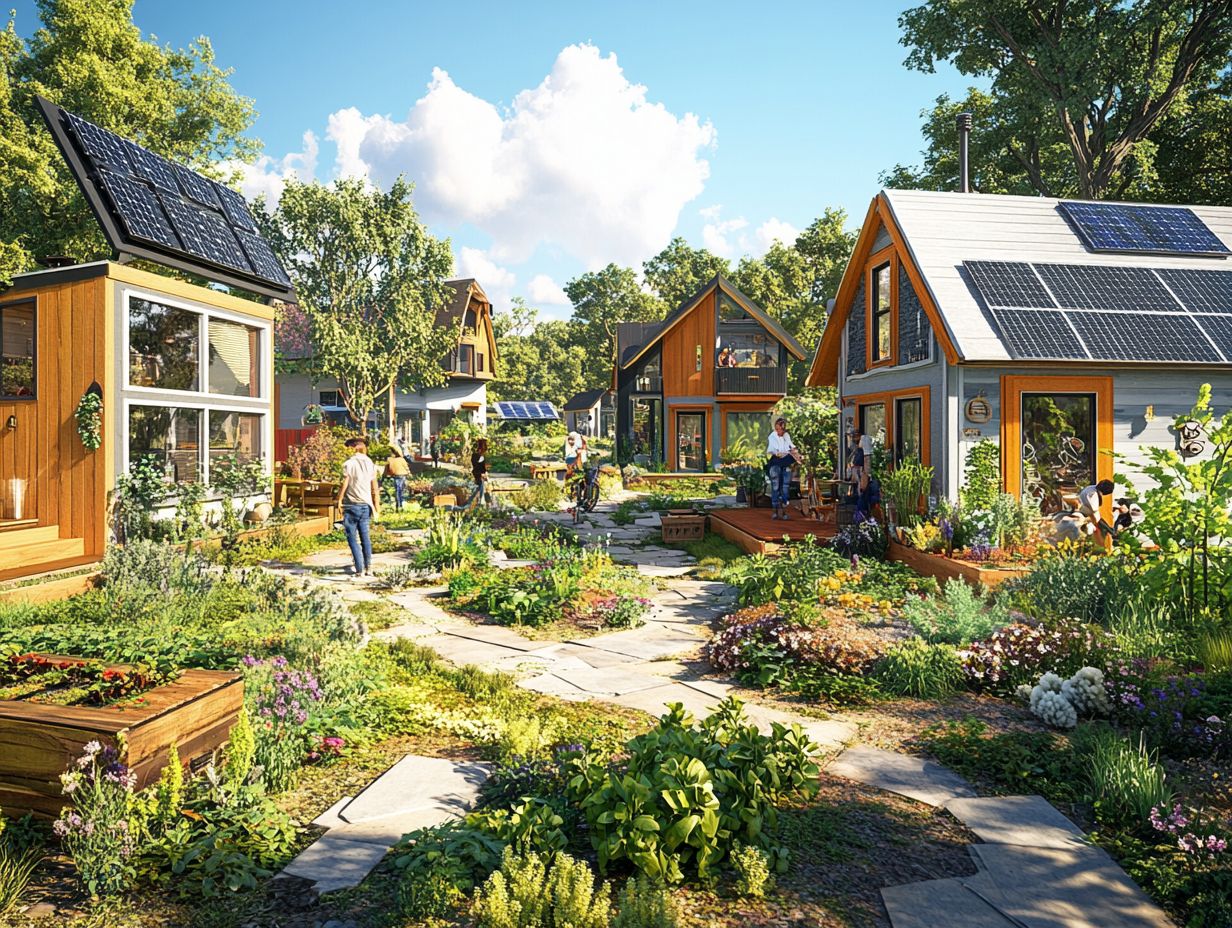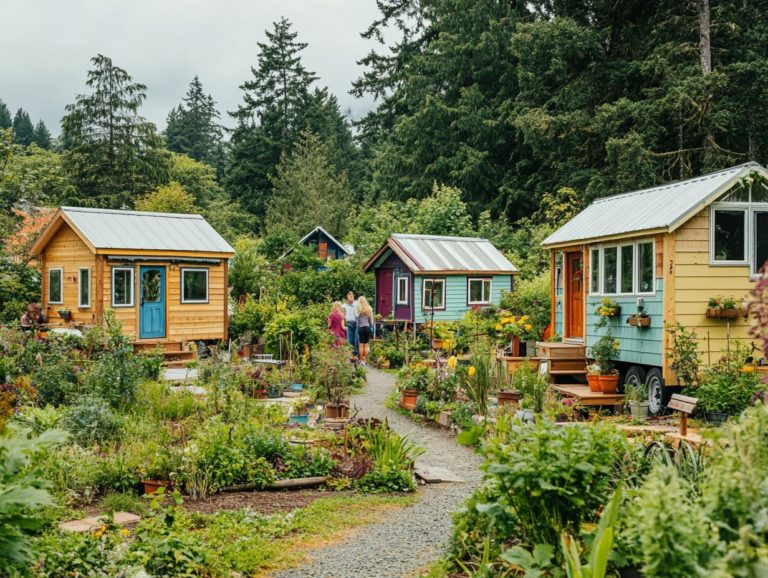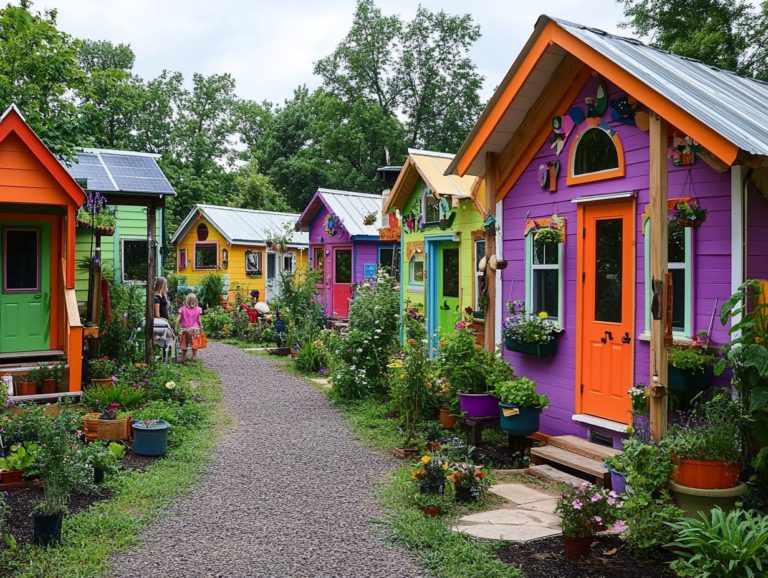Tiny House Communities: An Eco-Friendly Lifestyle
Tiny house communities transcend mere trends; they embody a transformative movement toward sustainable living and the cultivation of meaningful connections.
These compact neighborhoods present an unparalleled fusion of environmental awareness, financial savings, and robust community support. This article delves into what truly defines a tiny house community, highlights the myriad benefits of living within one, and offers practical advice for those looking to join or create their own.
It also covers important topics like legal regulations and community dynamics, ensuring you are thoroughly equipped for this eco-conscious lifestyle.
Contents [hide]
- Key Takeaways:
- What are Tiny House Communities?
- Benefits of Living in a Tiny House Community
- How to Join or Create a Tiny House Community
- Considerations for Living in a Tiny House Community
- Frequently Asked Questions
- 1. What is a tiny house community?
- 2. How does living in a tiny house community promote an eco-friendly lifestyle?
- 3. Are tiny house communities only for single individuals or can families live in them as well?
- 4. Are there any rules or regulations within tiny house communities?
- 5. How do I find a tiny house community to live in?
- 6. Can I build my own tiny house in a community or do I have to purchase one?
Key Takeaways:
- Living in a tiny house community promotes eco-friendly practices, helping reduce your carbon footprint and minimizing energy and resource consumption.
- Joining a tiny house community can lead to financial savings through shared resources and expenses while fostering a sense of community and support.
- When considering joining or creating a tiny house community, it is essential to research and understand legal and zoning regulations rules about how land can be used as well as the community’s rules and dynamics to ensure a successful and harmonious living situation.

What are Tiny House Communities?
Tiny House Communities embody a growing movement in sustainable living, inviting individuals and families to embrace the charm of tiny houses. This minimalist lifestyle emphasizes financial freedom, environmental stewardship, and a deep sense of community.
Within these neighborhoods, you’ll find a vibrant tapestry of residents united by their commitment to eco-friendly practices and low-impact living. These communities not only foster belonging but also tackle significant issues such as housing affordability and environmental sustainability. Additionally, tiny house community networking plays a crucial role in building connections among residents.
Influential advocates like Malia and Jen have played a pivotal role in popularizing these communities, shining a spotlight on the numerous benefits of communal living and the remarkable Tiny Home Movement. Understanding the legal framework of tiny house communities is also essential for those considering this lifestyle.
Benefits of Living in a Tiny House Community
Living in a Tiny House Community presents a wealth of advantages tailored for those who are passionate about an eco-friendly lifestyle. Imagine saving money on your utility bills while gaining financial freedom, all within a nurturing community that champions positive change.
These communities do more than just shrink your carbon footprint; they cultivate meaningful connections among residents who share your values, enhancing your overall living experience. For those interested in this lifestyle, understanding the pros and cons of tiny house community living can be invaluable.
Environmental Impact
The environmental impact of living in a tiny house community is impressively positive. These homes often embrace sustainable materials, prioritize energy efficiency, and significantly reduce your carbon footprint compared to traditional housing options. By making eco-friendly lifestyle choices, you contribute to reduced resource consumption and champion green builds that harmonize beautifully with nature.
Take, for example, the use of reclaimed wood and recycled materials in many tiny houses. This approach minimizes waste and alleviates the demand for new resources. Features like solar panels and composting toilets work tirelessly to conserve energy and water, further enhancing your ecological footprint. Additionally, tiny house communities offer unique benefits that contribute to sustainable living.
The long-term benefits of this lifestyle reveal themselves in decreased reliance on fossil fuels and a reduced risk of pollution, fostering a deep sense of ecological responsibility. By choosing to live in such communities, you actively join a movement that emphasizes preservation and sustainability. For those looking for more insights, tiny house community living tips recognize that each small decision you make contributes to the overall health of our planet.
In conclusion, exploring unique tiny house communities around the world may be your first step towards a more sustainable and fulfilling lifestyle. Consider the benefits and make a meaningful change today!
Financial Savings
Living in a tiny house community offers you significant financial savings. Here, residents often enjoy lower utility bills and reduced mortgage costs, paving the way for greater financial freedom. This lifestyle champions sustainable living through minimalism and tackles the pressing issue of housing affordability that many face today.
For instance, the average monthly utility expense for a tiny house can be as low as $50, while conventional homes often exceed $200. This is largely due to energy-efficient appliances and the reduced space requiring less heating or cooling.
Maintenance costs also take a nosedive, as smaller homes generally demand fewer repairs and replacements. A case study from a tiny house village revealed that residents experienced a remarkable reduction in overall living expenses by up to 50%. This allows you to channel your resources into savings or enriching experiences.
Ultimately, tiny house living cultivates a lifestyle that emphasizes financial stability and resilience against economic fluctuations, while also fostering connections through tiny house communities, enabling you to thrive in a changing world.
Community Support and Connections

Community support and connections are essential to your experience in a tiny house community, cultivating a genuine sense of belonging. This communal atmosphere encourages collaboration and the sharing of resources, paving the way for positive changes both individually and collectively.
By engaging in shared gardening projects or skills workshops, friendships blossom, deepening your sense of connection. For example, one resident shared how a simple potluck transformed into a cherished monthly tradition, sparking culinary creativity and nurturing a supportive network where advice and assistance flow freely.
Testimonies from residents underscore how the collaboration generated within these communities enriches their personal lives and amplifies their collective impact on sustainability, creating a brighter, more resilient future for everyone involved.
How to Join or Create a Tiny House Community
Joining or creating a tiny house community is a realistic goal for anyone drawn to sustainable and communal living. Resources abound through organizations like the Tiny House Society, which can help you discover existing communities or provide guidance for establishing a new one.
This journey promotes eco-tourism, bringing together like-minded individuals who share a commitment to an environmentally conscious lifestyle. Eco-tourism focuses on responsible travel to natural areas, conserving the environment, and improving the well-being of local people.
Finding Existing Communities
Discovering existing tiny house communities is a rewarding journey that introduces you to a network of like-minded individuals. Organizations like the Tiny House Society provide invaluable resources and directories to guide your exploration. These communities often champion eco-tourism and sustainable living, creating a warm and welcoming environment for newcomers.
To uncover these hidden gems, dive into various online platforms. Explore forums and dedicated websites that curate listings of tiny house communities by region. Additionally, check out tips for new residents in tiny house communities. Local meetups and workshops can also be excellent venues for connecting with fellow enthusiasts and learning about grassroots initiatives.
Social media groups on platforms like Facebook and Instagram offer real-time updates and insights into local events, keeping the sense of community alive. Supporting one another through shared experiences cultivates a deeper sense of belonging, making these connections a vital part of the tiny house lifestyle.
Join today to start your new adventure in sustainable living!
Building Your Own Community
Building your own Tiny House Community can truly be an enabling journey, allowing you to create a space that embodies your values of sustainable and communal living. This approach fosters an eco-friendly lifestyle where collaboration and shared resources take center stage.
Embarking on this venture is not just a project; it s a chance to build a vibrant community that reflects your values! Your first step involves carefully identifying suitable land. Consider factors like accessibility, water supply, and proximity to essential services these elements are crucial for your community’s success.
Once you’ve secured the land, local building rules will become critical. Understanding the local laws will ensure that your community develops smoothly and without legal complications.
Next, establishing a clear way for the community to make decisions together is essential. This framework will dictate community rules and responsibilities, creating a fun and friendly place to live.
Engaging potential residents in these discussions can further enhance community ties and nurture a sense of ownership. This way, your Tiny House Community transforms from merely a place to live into a nurturing home where meaningful relationships can thrive, as highlighted in understanding the dynamics of tiny house communities.
Considerations for Living in a Tiny House Community
Living in a Tiny House Community demands that you thoughtfully consider several key factors, such as legal and zoning regulations, community guidelines, and the practicalities of embracing a minimalist lifestyle.
By understanding these elements, you can facilitate a seamless transition into community life while embodying the fundamental principles of sustainable living and shared responsibility.
Legal and Zoning Regulations

Understanding the local rules for tiny homes is a must for anyone considering a life in a Tiny House Community. These factors play a pivotal role in determining the feasibility and legality of tiny homes under the International Residential Building Codes.
As a potential tiny house resident, you may encounter specific challenges, such as restrictive zoning laws that could label these charming dwellings as non-compliant or classify them as trailers instead of permanent residences. Many municipalities enforce minimum square footage requirements, making it a real struggle for tiny homes to meet the criteria. However, understanding the growing trend of tiny house living can help you navigate these obstacles more effectively.
Securing the proper permits for utilities like water and sewage can present significant hurdles. By grasping these intricate details, you not only safeguard your investment but also contribute meaningfully to the broader conversation surrounding sustainable living and affordable housing solutions.
Community Rules and Dynamics
Community rules and dynamics are essential to the success of Tiny House Communities, creating an atmosphere of mutual respect and support among residents. By establishing clear guidelines, you can ensure a harmonious living experience that fosters positive change and upholds communal living values.
These regulations not only define acceptable behaviors but also highlight the significance of cooperation and collaboration. By nurturing a sense of belonging and accountability, you and your neighbors can engage in sustainable practices and cultivate a culture of inclusivity.
Your commitment to these principles allows a diverse group to forge lasting relationships, ensuring that everyone feels valued and heard. Ultimately, a well-defined set of community rules encourages personal growth, enriches daily life, and enables you to contribute to a shared vision of simplicity and sustainability.
Practical Considerations for Living in a Small Space
Living in a Tiny House Community means making the most of your space and embracing a minimalist lifestyle. You need to use every square foot wisely while keeping it comfortable.
Discover exciting strategies that boost comfort and efficiency. Start by decluttering regularly; get rid of unnecessary items that crowd your limited space. Incorporating multifunctional furniture like sofa beds or foldable dining tables can significantly enhance the versatility of your living area.
Get creative with your storage solutions. Under-bed compartments and wall-mounted shelves can truly make a difference. Choosing light colors for your walls and furnishings creates an airy feel, enhancing the overall ambiance of your home.
By embracing these practical tips, you can transform your limited space into a cozy, functional haven tailored to your needs.
Frequently Asked Questions
1. What is a tiny house community?
A tiny house community is a neighborhood made up of small homes, usually no bigger than 500 square feet. These homes focus on being eco-friendly and sustainable.
2. How does living in a tiny house community promote an eco-friendly lifestyle?

Living in a tiny house community encourages a minimalist and environmentally conscious lifestyle. These communities often have communal gardens, shared resources, and use renewable energy sources to reduce the carbon footprint of residents.
3. Are tiny house communities only for single individuals or can families live in them as well?
Tiny house communities welcome individuals, couples, and families of all sizes. The homes may be small, but they are designed to maximize space and accommodate families with children.
4. Are there any rules or regulations within tiny house communities?
Each tiny house community may have its own set of rules and regulations. Generally, guidelines are in place to ensure the community remains sustainable and harmonious. These may include restrictions on the size and design of homes, as well as rules for waste management and resource-sharing.
5. How do I find a tiny house community to live in?
There are various ways to find a tiny house community, such as online directories, social media groups, and word of mouth. Additionally, attending tiny house events and workshops can help you connect with others and learn about different communities in your area.
6. Can I build my own tiny house in a community or do I have to purchase one?
Most tiny house communities allow residents to either purchase or build their own tiny homes. However, there may be restrictions on materials, size, and design to ensure they meet community standards for sustainability and aesthetics.






